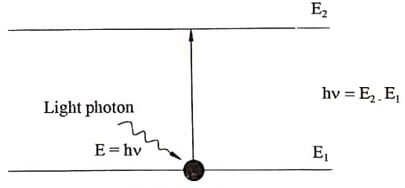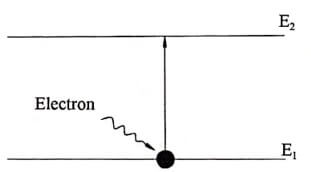It is the process by which the atoms in the lower energy state are raised to the highest energy state in the active medium to create population inversion is called pumping action.
It is an essential requirement for producing a laser beam. The commonly used methods for pumping action are:
- Optical pumping
- Direct conversion
- Electrical discharge method
- Inelastic collision between atoms
- Chemical method
i. Optical pumping ( excitation by photons)
In optical pumping, high energy light source like xenon flash lamp is used to excite the atoms. The atoms in the ground state are pumped to an excited state by absorbing photons of frequency ν.
Example: Ruby laser and Nd: YAG laser.

Fig. 1.1 Optical pumping
ii. Direct conversion
In certain situation, a direction conversion of electrical energy into light energy takes place without exciting the atoms of the material. This is called direct conversion.
Example: Semiconductor laser (Ga – As laser)
 Fig. 1.2 Direct Conversion
Fig. 1.2 Direct Conversion
iii. Electrical discharge method (Excitation by electrons)
In this method, electrons are released from gaseous atoms by means of high voltage electric discharge through the gas. Here, electrons are produced in an electrical discharge tube. These electrons are accelerated to high velocities by a strong electric field. The accelerated electrons collide with active atoms and raise it to the excited state to achieve population inversion. This method is called electrical discharge method. (Fig.1.3).
Example: Argon ion laser, CO2 laser.

Fig. 1.3 Electrical discharge method
A + e*→A* + e
iv. Inelastic collision between atoms
In this method, a combination of two types of gases are used, say A and B, both are having the same excited state A* and B* that coincide or nearly coincide.
In the first step, during electric discharge, A get excited to A* due to collision with electrons. The excited A* atoms collide in elastically with B atoms, so that the later atoms get excited to higher energy B*.
Example: He-Ne laser.
A + e*→A* + e
A* + B → A + B*

v. Chemical Method
In this method, instead of optical energy, chemical energy from the chemical reaction is used to achieve the population inversion.
Example: Hydrogen fluoride chemical laser
An example for this type of laser is hydrogen fluoride chemical laser, in which hydrogen fluoride molecules in the excited state result from the following chemical reaction: H2 +F2 → 2(HF)*
| Read More Topics |
| Numerical aperture and acceptance angle |
| Introduction and construction of fibre optics |
| Medical application of laser |





